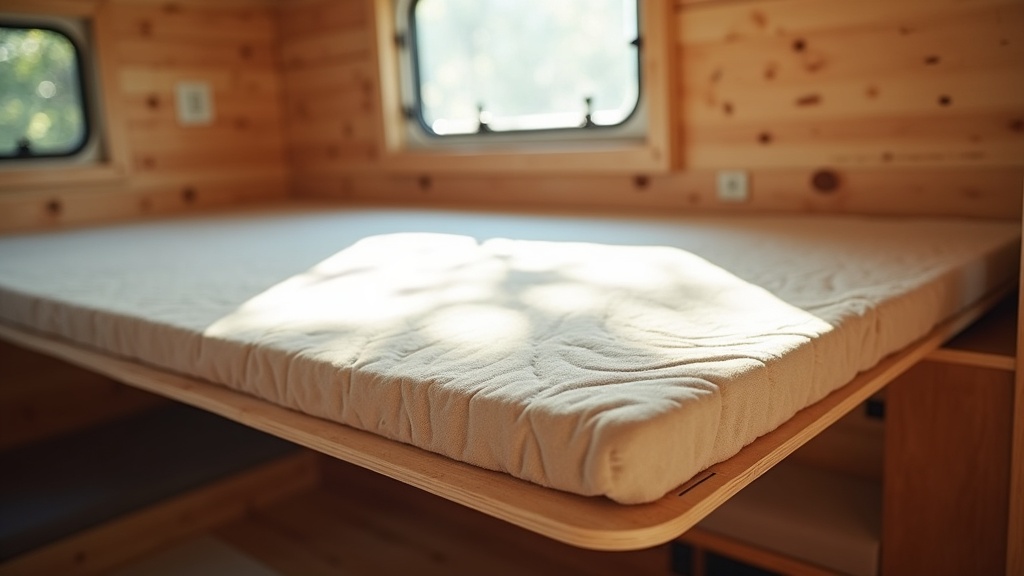Anyone who’s ever climbed into bed after a long day on the road in their RV knows the feeling. You’re wiped out, ready for a solid night’s sleep, but the mattress is about as comfy as a futon in a college dorm. It’s a super common topic with RVers and there are legit reasons why so many ask: Why do RV mattresses suck? I’ve been there too, tossing and turning, then finally giving up and looking for better options. Here’s why RV mattresses are so notoriously bad, and how you can actually get a good night’s sleep on your next trip.

Table of Contents
- Why RV Manufacturers Skimp on Mattresses
- RV Weight: Why It Matters
- The Weird World of RV Mattress Sizes
- Assumptions About RV Sleeping Habits
- Space Constraints and Design Limitations
- What Can You Do About a Bad RV Mattress?
- Frequently Asked Questions About RV Mattresses
- Final Thoughts
Why RV Manufacturers Skimp on Mattresses
RV beds are rarely a selling point in dealer showrooms. Most buyers don’t even try them before buying their rig. Because of that, RV makers have figured out mattresses are an easy area to cut corners and save money. They’re usually pretty upfront about where they invest, like fancy lighting or cool sound systems, but the bedding is often an afterthought since it’s not something people focus on during a sales tour.
Keeping costs low is really important for RV manufacturers so they can offer lower priced models and meet sales goals. Swapping in a super cheap, basic mattress saves them cash right away, and most customers won’t realize the difference until after purchase. Some folks expect everything in an RV to feel just like home, but while the kitchen might wow you with appliances and storage, the bed is left average at best. If you’ve ever compared a home mattress to what’s in your travel trailer or camper, you know what I mean.
RV Weight: Why It Matters
Every pound counts when it comes to building RVs. A heavier RV means lower fuel efficiency and trickier towing, so manufacturers look for ways to cut weight. Mattresses are no exception. RV beds are often super lightweight, made from thin foam or budget innerspring materials that weigh less than a typical home mattress. This is especially important when you factor in towing safety and legal weight restrictions.
Lightweight mattresses mean your RV stays under max weight limits, which can help you avoid potential issues with your tow vehicle or exceeding the gross vehicle weight rating (GVWR). But that weight savings almost always comes at the expense of comfort. In the real world, shaving a few pounds off the mattress doesn’t make up for nights of back pain or restless sleep. Even as RVers add accessories and gear for the road, having a lighter mattress seems smart on paper but leads to disappointment when you finally settle in for shuteye.
The Weird World of RV Mattress Sizes
If you’ve ever tried to buy sheets or a mattress topper for your RV, you already know they come in a bunch of oddball sizes. Most RVs don’t use standard queen or king mattress dimensions. Instead, you get “short queen,” “RV full,” or “narrow bunk.” Some even have one corner chopped off to fit into a slideout or rounded wall. This makes finding a replacement or a fitted cover almost impossible from big box stores.
These strange dimensions make mass producing a quality, supportive mattress a lot harder. The beds usually end up thinner and less supportive just to fit in the weird shapes and spaces in the RV, which means you’re stuck with something that feels more like a thin camping pad than a real mattress. And if your RV has bunks for kids or guests, those sizes are rarely available at local stores. Ordering custom bedding or trimming toppers turns into a project instead of a quick update.

Assumptions About RV Sleeping Habits
RV manufacturers tend to think most owners use their rigs only on weekends or occasional trips. Because of that, they just don’t prioritize long-term comfort. In their eyes, if you’re not sleeping in the RV bed for weeks at a time, why invest in plush, high-quality bedding? That logic might make sense for people who only camp a handful of weekends each year, but for full time RVers or those taking longer trips, the lack of comfort gets old fast.
Plenty of folks eventually realize even a couple of nights on a bad mattress can make a camping trip less fun. Comfort should be part of the adventure, so if you want to enjoy waking up in your rig, an upgrade is basically the way to go. Even weekend warriors who want to get up and hit the trails early will appreciate having a real mattress. Sleeping well should never be an afterthought, especially when it shapes your entire vacation experience.
Space Constraints and Design Limitations
Some sleeping spaces in RVs are seriously tight. Slideouts, corners, bunks, and over the cab areas all place demands on mattress thickness and flexibility. The bedding needs to bend or even fold when slideouts are retracted, and it can’t be so thick that it blocks cabinets, windows, or moving parts. The result: mattress designs are often limited to thin foam or really flexible materials. Even if you wanted a plush pillowtop, you couldn’t always squeeze it into the spot where the manufacturer stuck your bed.
I’ve seen mattresses crammed into spaces so strange, they look like Tetris pieces. When comfort is forced to take a backseat to function, your mattress pays the price. And for some smaller rigs or van conversions, even finding a mattress thin enough to fit under overhead storage can be a challenge. Light padding might work for one person and not for another, so RV sleep comfort is never one size fits all.
What Can You Do About a Bad RV Mattress?
The good news is plenty of RVers have found easy fixes that really give a boost to sleep quality. Replacing your mattress completely or just adding a topper can turn a painful night into solid sleep, even if you’re dealing with a tiny bunk or odd shape.
- Try a residential mattress: If your space allows, some standard home mattresses (like Twin XL or Short Queen) can be trimmed or squeezed into the RV bed frame. Foam mattresses, especially, can often be cut to fit really strange dimensions using a sharp bread knife or electric carving knife.
- Use a mattress topper: Memory foam or latex toppers add a ton of comfort for not much money and are easy to trim for custom sizes. I’ve had great luck with both, and they’re simple to store if you only need them for certain trips.
- Custom RV mattresses: Companies like rvmattress.com and brooklynbedding.com (not sponsors, just stuff I use myself!) make mattresses specifically for RVers. You can order by size, cut, and thickness so you actually get something comfy that fits the bed platform in your rig. While not a sponsor of rvlifeescapes.com I do get a small reward if you purchase a bed at this link.
It’s always worth checking reviews and real-world feedback before buying, because prices and comfort levels can vary a ton. Also, consider checking online groups or forums for up to date advice from other travelers. Many RVers have tracked down affordable fixes tailored to even the strangest spaces. Don’t give up hope! Once you get a comfortable bed set up, it instantly changes how you feel about hitting the road.
Frequently Asked Questions About RV Mattresses
There’s a reason questions about RV bedding pop up all the time. Here are answers to some of the ones I hear most:
Question: Can’t I just use a regular home mattress in my RV?
Answer: Sometimes you can, but it really depends on space and weight. Foam mattresses are easier to trim and fit into odd spots, but heavier options might not be a good match if you need to keep your RV weight down. Always measure first and consider how you’ll get it into the rig!
Question: Are all RV mattresses uncomfortable?
Answer: Most original ones aren’t great, but you can get a much better sleep by swapping them out or using toppers. Loads of brands now cater to unusual RV bed sizes, so you’re not stuck with the original forever.
Question: Why are most RV mattresses so thin?
Answer: Thinner mattresses keep weight down and fit tricky spots like bunks, over cab areas, or slideouts, where a big, thick mattress would just get in the way. Plus, it helps manufacturers keep costs low and designs practical.
Final Thoughts
RV mattresses are pretty notorious for being uncomfortable, but knowing the reasons behind it helps you figure out what to do about it. From cost cutting to weird sizes and tight spaces, there’s a reason they’re often disappointing right from the factory. The plus side is you’ve got options for upgrading your sleep setup and making your travels a lot happier, and a lot less sore in the mornings. If you’re fighting with a bad mattress right now, you’re definitely not alone. The more you learn, the easier it becomes to find solutions that fit your rig and your sleep style—so here’s to wakeful mornings and pain free adventures on your next trip!
About the Author
Jim has 3.5 years of experience living and traveling full-time in an RV. From “moochdocking” with family and friends to navigating the financial intricacies of RV life, he shares practical advice rooted in firsthand experience. His goal is to help fellow adventurers embrace the RV lifestyle with confidence and ease.
Curious about our policies? Feel free to read our affiliate disclosure.

